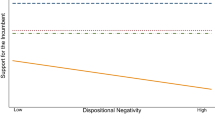Abstract
The tendency for negative information to have more weight than equally extreme or equally likely positive information appears in a variety of cognitive processing tasks, but has rarely been documented empirically in politics. This paper provides evidence for two types of negativity effects in electoral behavior: negativity in the formation of impressions (of Humphrey and Nixon in 1968, of McGovern and Nixon in 1972, and of Carter and Reagan in 1980), and negativity as a consequence of impressions (in the 1974 and 1978 congressional elections). Both post hoc rationalization and the nonequivalence of the positive and negative information were examined and ruled out as artifactual explanations for these results. Discussion centered around two possible explanations for negativity, a cost-orientation hypothesis (which holds that people are more strongly motivated to avoid costs than to approach gains) and a figure-ground hypothesis (which holds that negative information stands out against a general positive background).
Similar content being viewed by others
References
Anderson, N. H. (1965). “Averaging vs. Adding as a Stimulus Combination Rule in Person Perception.”Journal of Experimental Psychology 70: 394–400.
Beigel, A. (1973). “Resistance to Change: Differential Effects of Favorable and Unfavorable Initial Communications.”British Journal of Social and Clinical Psychology 12: 153–158.
Bloom, H. S., and H. D. Price (1975). “Voter Response to Short-run Economic Conditions: The asymmetric Effect of Prosperity and Recession.”The American Political Science Review 69: 1240–1254.
Brody, R. A., and B. I. Page (1972). “The Assessment of Policy Voting.”The American Political Science Review 66: 450–458.
Campbell, A., P. E. Converse, W. E. Miller, and D. E. Stokes (1960).The American Voter. New York: Wiley.
Campbell, A., P. E. Converse, and W. L. Rodgers (1976).The Quality of American Life. New York: Russell Sage.
Converse, P. E. (1966). “The Concept of a Normal Vote.” In A. Campbell et al. (eds),Elections and the Political Order. New York: Wiley.
Festinger, L. (1957).A Theory of Cognitive Dissonance. Stanford: Stanford University Press.
Folkes, V. S., and D. O. Sears (1977). “Does Everybody Like a Liker?”Journal of Experimental Social Psychology 13: 505–519.
Hamilton, D., and M. Zanna (1972). “Differential Weighting of Favorable and Unfavorable Attributes in Impressions of Personality.”Journal of Experimental Research in Personality 6: 204–212.
Heider, F. (1958).The Psychology of Interpersonal Reactions. New York: Wiley.
Kahneman, D., and A. Tversky (1979). “Prospect Theory.”Econometrica 47, 263–278.
Kanouse, D. E., and L. R. Hanson, Jr. (1972). “Negativity in Evaluations.” In E. R. Jones et al. (eds.),Attribution: Perceiving the Causes of Behavior. Morristown, N.J.: General Learning Press.
Katz, D., B. Gutek, R. L. Kahn, and E. Barton (1975).Bureaucratic Encounters. Ann Arbor: Institute for Social Science Research.
Kernell, S. (1977). “Presidential Popularity and Negative Voting.”The American Political Science Review 71: 44–66.
Kinder, D. R. (1978). “Political Person Perception: The asymmetrical Influence of Sentiment and Choice on Perceptions of Presidential Candidates.”Journal of Personality and Social Psychology 38: 859–871.
Kinder, D. R., S. T. Fiske, and R. G. Wagner (1980). “Presidents in the Popular Mind: Processes of Leadership Appraisal.” Unpublished manscript, Yale University.
Kinder, D. R., M. D. Peters, R. P. Abelson, and S. T. Fiske (1980). “Presidential Prototypes.”Political Behavior 2: 315–338.
Koenigs, R. J. (1974). “The Relative Influence of Positive and Negative Trait Adjectives on Impression Formation and Persistence.”Dissertation Abstracts International 34: (8A, part 2), 5312–5313.
Kogan, N., and M. A. Wallach (1967). “Risk Taking as a Function of the Situation, the Person, and the Group.” InNew Directions in Psychology III. New York: Holt.
Lau, R. R. (1979). “Negativity in Person Perception with Applications to Political Behavior.” Doctoral dissertation, UCLA.
Lubfer, M., M. Jones, and C. Quin (1972). “Group Risk Taking as a Function of Three Types of Monetary Incentives.”Journal of Personality 80:273–282.
Miller, A. H., M. P. Wattenberg, O. Malanchuk (1982). “Cognitive Representations of Candidate assessments.” Paper presented at the annual meeting of the American Political Science Association, Denver.
Mueller, J. E. (1973).War, Presidents, and Public Opinion. New York: Wiley.
Myers, J. L., R. E. Reilly, and H. A. Taub (1961). “Differential Cost, Gain, and Relative Frequency Reward in Sequential Choice Situation.”Journal of Experimental Psychology 62: 357–360.
Raven, B. A., and P. S. Gallo (1965). “The Effects of Nominating Conventions, Elections, and Reference Group Identification upon the Perception of Political Figures.”Human Relations 8: 217–230.
Rettig, S. and B. Pasamanick (1964). “Differential Judgements of Ethical Risk by Cheaters and Noncheaters.”Journal of Abnormal and Social Psycholog 69: 109–113.
Richey, M., L. McClelland, and A. Shimkunas (1967). “Relative Influence of Positive and Negative Information in Impression Formation and Persistence.”Journal of Personality and Social Psychology 6: 322–327.
Sears, D. O. (1969). “Political Behavior.” In G. Lindzey and E. Aronson (eds.),The Handbook of Social Psychology, Volume 5. Menlo Park: Addison-Wesley.
Sears, D. O. (1982) “A Person Positivity Bias.”Journal of Personality and Social Psychology, in press.
Sears, D. O., and R. E. Whitney (1974). “Political Persuasion.” In I.D.S. Pool and W. Schramm (eds.),Handbook of Communication. New York: Rand McNally.
Slovic P. (1969). “Differential Effects of Real Versus Hypothetical Payoffs on Choices among Gambles.”Journal of Experimental Psychology 80:434–437.
Tesser, A., and S. Rosen (1975). “The Reluctance to Transmit Bad News.” In I. L. Berkowitz (ed.),Advances in Experimental Social Psychology, Volume 8. San Francisco: Academic Press.
Weisberg, H. F., and J. G. Rusk (1970). “Dimensions of Candidate Evaluations.”The American Political Science Review 64: 1167–1185.
Author information
Authors and Affiliations
Rights and permissions
About this article
Cite this article
Lau, R.R. Negativity in political perception. Polit Behav 4, 353–377 (1982). https://doi.org/10.1007/BF00986969
Issue Date:
DOI: https://doi.org/10.1007/BF00986969




